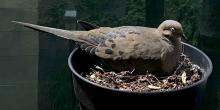
During the lockdown...
During the lockdown, every conversation, which occurs either online or behind a mask while standing the recommended six feet apart, has started with a story of experiencing a new order to our lives. As someone born in Texas, this is not a welcome change from the previously polite discussion about the weather which used to be the only shared experience agreed upon as a safe topic.
A few months ago we were complaining about how hectic and busy we were in our jobs and careers. Now the shock of staying at home feels devastating. Back-to-back Zoom meetings fill our days with little-to-no human contact. Yet the days fly by as many of us bury ourselves in our work in an attempt to feel normal.
Despite the challenge of work and everything changing in response to the COVID-19 pandemic, I have slowed down enough to enjoy two new companions. Two mourning doves have nested on the balcony of my condo building. Their names are Henrietta and Rufus. And there are two eggs in the nest with the promise of life to come. I will admit that I’ve never been much of a bird watcher. Too much go-go-go for me, although these feathered friends seem not to mind spending three weeks quietly and patiently tending to their eggs. Their color is much more subtle than other bird species such as the peacock so confirming the gender has been a challenge for me and required a bit of online research. In the process of oversharing (yes, of course I have posted on Instagram at @jtalasek #isolationseries), I’ve even been teased by friends and colleagues that I’m forcing gender constructs on these poor animals. “I don’t care who is what, as long as they are happy in the nest together” and “They’re too at ease on the planet for ridiculous constructions. As for sex, are human labels appropriate?” I must admit as I laugh at my own unrecognized gender bias, I assumed it would be Henrietta on the nest most of the time. In fact, although they take turns incubating the eggs, I have noted it is Rufus that is clocking more “stay at home” time with the future kids. He is gently turning one of the eggs now as I write. Or maybe Henrietta works the night shift and I just don’t see her as much.
Because of where I was born, I had exposure at an early age to Native American teachings. The philosophies of working with the earth rather than dominating it, listening to nature rather than forcing it, and reading signs and warnings that earth shares in its own language are more ideas than actions today. Such ideas would require us to slow down. The thread that runs through the news now is the same every day- the question of “when we will return to normal?” While visiting with Henrietta and Rufus just a few feet away separated by a glass door, a statement that I heard during this unsettling experience resonates in my head: “Why return to normal? Let’s return to better.” Those of us in the thought community of integrative and collaborative work across disciplines and communities know well what this means as we have talked about it often. We know we can shift society over time with persistence, compassion, and empathy through collaboration using all of the tools in our toolbox—knowledge learned from our many disciplines and systems of knowledge. This is our catalyst that ignites change for the better. Though we have all experienced great disasters in our lives, this is the one event that has impacted every person on the planet. But as the saying goes, it starts with the person in the mirror. As these feathered ambassadors of nature have taught me, I will never take for granted again the preciousness of time, our dependence on one another at all levels of our society, or an opportunity to hug another human or offer a friend a handshake.
JD Talasek
Director, Cultural Programs of the National Academy of Sciences
